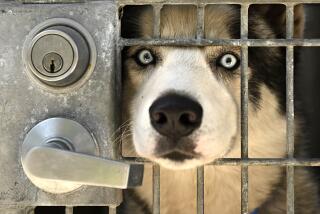What to Get for the Pet Who Has Everything
Pet paraphernalia has turned from the mundane--sweaters and treats and toys--to a “Ripley’s-Believe-It-Or-Not” mode this holiday season.
How about doggie jogging suits and gourmet frozen dinners, Palm Beach dog biscuits in the shape of a 1954 Bentley, fur coats and bow ties for cats and rabbits, non-alcoholic catnip liqueur, water wings and water beds, pet cologne in scents of the Chanel, Opium or Giorgio types, Catnastics exercisers for your overweight kitty?
Or, if you’re really in the money, there’s a $1.1-million cat house.
Honest.
Pets are, after all, a multibillion-dollar business.
Pet-food industry spokesmen say that $5 billion a year is spent in the United States for pet food alone, and they estimate that millions more are spent on pet accessories, grooming and health care.
Biggest Spenders
And Californians spend more money on their animals than pet owners of any other state.
“In California, we spend about two times what everybody else is spending on their pets,” said Tom McLaughlin, executive vice president of the Western World Pet Supply Assn. in South Pasadena, a nonprofit pet-industry organization. “It’s easier to keep pets here; the weather’s nicer, we have more space, etc.”
By far, the most expensive single gift item found was the million-dollar Egyptian temple for cats, made of malachite, lapis, quartz, turquoise and carnelian and inlaid with 14-carat gold.
To date, the SoHo gallery in New York, Villas Boas Collections, which is offering the extravagant four-foot-high feline home hasn’t sold any, but it’s had “lots of requests for pictures and info,” according to gallery manager Randi Larowitz.
Larowitz said that less expensive faux models of the cat temple, without real gemstones, have been purchased.
Downscale Models
Villas Boas, an antique and furniture gallery, has also been selling quite a few downscale models of dog and cat houses that it has included among its holiday gift items this year.
“Most of the homes range from $500 to $11,000,” Larowitz said, explaining that the designs for the houses are created by Cannon Garber of New York. “We take a measurement of your dog before we sell the house,” added Larowitz. “Most of the models are for small to medium dogs, and they have to be rescaled for larger ones.” Pillows, filled with cedar chips, down or potpourri, come with each.
Architectural plans and a deed are included with each house, whether for a dog or cat.
The latest concept in dog houses includes models of a Swiss chalet, two kinds of French chateaux, an Art Deco, an English manor and a Spanish colonial in a price range of $2,900 to $11,000. There are two additional cat homes, one that resembles a pyramid, the other, a Persian temple, complete with Persian rug and pillows with tassels.
“We see the houses as functional furniture,” said Larowitz. “You have to look at it as for yourself and your pet. There are a lot of people out there who love their animals and love their homes. It’s important for their homes to look a certain way. They might want to have their pet’s home out in the garden, or inside the house. Animals like their own space as much as people.”
For ritzy birds, Villas Boas has come up with an elaborate Bird Sanctuary with a combination of steps and columns that is supposed to resemble Roman ruins. At $980, it is a fancy perch, not a cage.
For your fat feline, there is also Catnastics, price $1,800. “It’s like a Tinker Toy construction of wood and steel that the cat can climb,” said Larowitz. “A cat Nautilus.”
On the fashion side for pets, jogging suits and fur coats are the stylish apparel this year, but Santa hats and suits still hold the record in seasonal popularity.
“The jogging suits, especially the vinyl black-and-yellow one with boots for foul-weather gear, have been very popular here,” said Joe Maslar of Towne House Grooming in New York City, who has been in the grooming and accessories business almost 20 years. “And people like the new leather and fur coats we have this year. But the Santa suits--we make them here at the store--have just been flying out the door.”
In Los Angeles, Bowser Boutique’s Bill McGrath, called Uncle Bill “McGraph” by his customers, concurred about the brisk sales of Santa clothing, mostly for dogs.
“Cats don’t wear clothes,” McGrath insisted. “If I put a sweater on my 16-year-old cat, he’d leave home.”
Commenting on the sale of Santa items, McGrath said: “In 16 years, I’ve always carried Santa hats and suits, but I can’t keep them in the store this year. This hasn’t happened since Watergate. They bought Santa stuff then, too. I think this Iran- contra thing has people subconsciously in a depressed state, so they’re in a strange mood and doing strange things. I wouldn’t notice it, except as their moods relate to their animals.”
In addition to Santa items, McGrath said that one of his biggest sellers is a three-foot rawhide chew bone priced under $20. For $15 more, dog owners can buy a specially made red-and-white stocking for the oversized chew bone.
In the most-popular-cat-toy-department is Cosmicrat, sold at Montana Paws, a new cat fanciers’ store in Santa Monica.
Although Montana Paws has more items for cat owners than felines, the shop owners have had a hard time keeping Cosmicrat in stock.
“They’ve just sold instantly,” said Topo Swope, one of the three owners. “I have 20 people on a waiting list right now.” The felt rats, which sell for $10 and are handmade, run across the floor when a string, attached to a ceramic spool underneath, is pulled.
Both Bowser Boutique and The Pet Dept, with stores in West Los Angeles, West Hollywood and Santa Monica, report that pet colognes are popular gifts this year. Made by Cardinal products, there are three fragrances: New York (Chanel-type), Paris (Opium-type) and Beverly Hills (Giorgio-type).
Before this year, relatively few clothing items have been manufactured for cats, most people believing as McGrath does that cats would hate clothing.
But Jenny Distler, a former computer programmer who recently started a new cat clothing firm, CatHouse Fashions in Dallas, said her business is doing well.
“We just started marketing the items a month ago, and they’re very popular,” said Distler. “I had always made things for my own cat, Channing--jewelry and toys--but I never could find other things out there for cats. A lot of dog sweaters, but not much for cats.”
Among CatHouse’s best-selling items is a kitty bow tie, a fur cape, a turtleneck sweater. “Rabbits seem to like the sweaters, too,” said Distler. “Because they’re warm. We’ve found that cats like them. We’ve had cat fashion shows at the cat shows and find that a lot of cats, when you dress them up, they start prancing around and show off for the other cats.”
Distler is so confident about her cat clothing line that she said: “If we can find a cat that won’t wear one of our sweaters, we’re offering $100.”
“I really expected people to be asking, ‘How can you be making cat clothes when people are hungry and homeless on the street?’ ” said Distler. “But I have been surprised that not that many people have.”
More popular than clothing, however, is Distler’s non-alcoholic Catnip Liqueur, a 16-ounce bottle of concentrate that is “best mixed with milk or cream.”
Catnip liqueur aside, many pet owners seem to have turned to natural foods for their animals.
“So many of our customers are into the health food for their pets, just like they want health food themselves,” said Rose Nevin of The Pet Dept. “They want the things with no sugars, no preservatives. A large percentage of our customers buy natural stuff.”
Nevin said that the frozen gourmet dinners, packaged like frozen dinners for people, are also gaining in popularity among pet owners. “They look like little meat loaves,” she said. “And they’re sort of in between the dry food and the canned. Our dry food has all the nutrition, plus it cleans their teeth. The canned food has more flavor, but it has a lot of water and isn’t as balanced as the dry. The frozen dinners have the nutrition and fiber of the dry and the flavor of the canned.”
Among the most unusual of the all-natural dog treats are the Palm Beach dog biscuits for dogs with sophisticated taste. The treats are cut in the shape of a 1954 Bentley automobile. Wendy Fielding, a waitress and sculptor when she is not baking dog cookies, hand-makes the biscuits of whole wheat flour, molasses, eggs and cornmeal. A package of six costs $3.50 at Fielding’s Rolling in Dough company in Palm Beach.
Other unusual gift items found in Los Angeles pet stores include brass beds and water beds; plastic screens to hide cat litter boxes; collars and leashes made of camouflage material; a “floater” for dogs, foam-like water wings so the pet can float in the pool; a doggie aerobics book, and a life-sized plastic fireplug.






